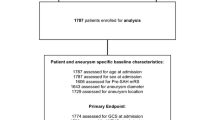Summary
Background and Objective. Factors related to prognosis after subarachnoid haemorrhage (SAH) have been mainly extracted from surgical series, and only few authors have considered these factors in total management or population series. Though the level of consciousness is a major determinant of outcome after subarachnoid haemorrhage, there is not a consensus about which classification should be used to define it. The objective of this study was twofold. Firstly to find which factors recorded on hospital admission relate to outcome determining their relative importance in a non-selected series of patients suffering from aneurysmal SAH admitted to our centre, and secondly to assess the validity of the WFNS clinical scale for predicting the final result.
Methods. A series of 294 patients consecutively admitted to Hospital 12 de Octubre Madrid between January 1990 and June 2000 with the diagnosis of aneurysmal SAH were retrospectively reviewed. All factors possibly related to prognosis were recorded on hospital admission. Outcome was measured by means of the Glasgow Outcome Scale measured one month after hospital discharge. Relationship between factors and outcome was evaluated by univariate and logistic regression multivariate analysis.
Results. Although several factors appeared related to prognosis in the univariate analysis, only the age, the level of consciousness defined by the WFNS scale and the presence of global brain hypodensity on the initial CT scan had a significant prognostic influence in the logistic regression model. Global brain hypodensity was strongly related to mortality. Since a number of factors associated with poor outcome in the univariate analysis are related to age, their influence could be explained by the difficulty of recovery of the ageing brain. The WFNS grading scale failed to predict significant differences in outcome between some of its grades.
Conclusions. Age and clinical grade on admission are the most important factors influencing the final outcome of patients suffering aneurysmal SAH. A reappraisal of the WFNS grading scale should be considered as no significant differences in outcome were found between some of its grades.
Similar content being viewed by others
Author information
Authors and Affiliations
Rights and permissions
About this article
Cite this article
Lagares, A., Gómez, P., Lobato, R. et al. Prognostic Factors on Hospital Admission after Spontaneous Subarachnoid Haemorrhage. Acta Neurochir (Wien) 143, 665–672 (2001). https://doi.org/10.1007/s007010170044
Issue Date:
DOI: https://doi.org/10.1007/s007010170044



